How Rivian saved $2.5M per year, supercharged satisfaction, and scaled by centralizing on Atlassian cloud

We found we could save $2.5M annually on tooling by centralizing on Atlassian Cloud and adding governance. That’s an annual cost savings of 36%.
Emily Novak
Product Manager, Digital Workspace & Solutions, Rivian
36%
Annual tool cost savings by centralizing on Atlassian cloud
750
Hours saved per person per year with one Automation solution
2,200
Monthly internal purchase requests managed with Atlassian
About Rivian
Rivian (NASDAQ: RIVN) is an American automotive manufacturer that develops and builds category-defining electric vehicles and accessories. The company creates innovative and technologically advanced products that are designed to excel at work and play with the goal of accelerating the global transition to zero-emission transportation and energy.
Challenge: As Rivian scaled from an ambitious electric vehicle startup to a publicly traded company, their toolset grew too, hindering efficiency, effectiveness, and user experiences.
Solution: Rivian centralized on Atlassian Cloud Enterprise and improved their ways of working with the help of Jira, Jira Service Management, and other integrated tools.
Impact: The EV pioneer is saving 36% on annual tool costs, 750+ hours/person every year with Automation, and improving the user experience by balancing autonomy with governance.
Reducing carbon through collaboration
Some SUVs and trucks drive on trails. Rivian is blazing them. As the first automaker to bring a fully electric pickup to the consumer market, Rivian is on a far bigger mission: stop the carbonization of our atmosphere.
Rivian has signed the Climate Pledge to reach net-zero carbon emissions by 2040 — 10 years ahead of the Paris Agreement. Reaching this goal and helping the world transition toward sustainable energy requires bringing individuals and entire industries together to rethink everything from specific technologies and processes, to the wider culture and systems they exist within.
“Building a collaborative culture is critical for us to deliver on our mission,” Rivian says. The teams tackling this enormous challenge power their work with the Atlassian cloud platform.
As Rivian grew quickly from an ambitious startup to a world-renowned, publicly traded company, their collection of tools grew too, hindering efficiency, effectiveness, and the user experience. To reach their goals, they had to improve their tools and their ways of working.
By centralizing on Atlassian Cloud Enterprise and improving their ways of working, the EV pioneer is saving over $2.5 million annually, making more informed decisions, and improving the user experience by balancing autonomy with governance.
Building a business case for consolidating and migrating after massive growth
Over the course of four years, Rivian’s workforce grew exponentially. The company wanted to maintain the freedom their 90+ teams had come to expect and rely on for innovation. But like any fast-growing business with big ambitions, they also needed to standardize ways of working for the sake of efficiency and savings.
To begin addressing these challenges, Rivian created a committee with a clear goal: improve the selection of systems and tools available to employees, while aligning teams with the platforms needed to do their best work.
At the time, the company had multiple software suites. Product Manager Emily Novak and her Digital Workplace & Solutions Team analyzed each toolset to better understand usage across departments.
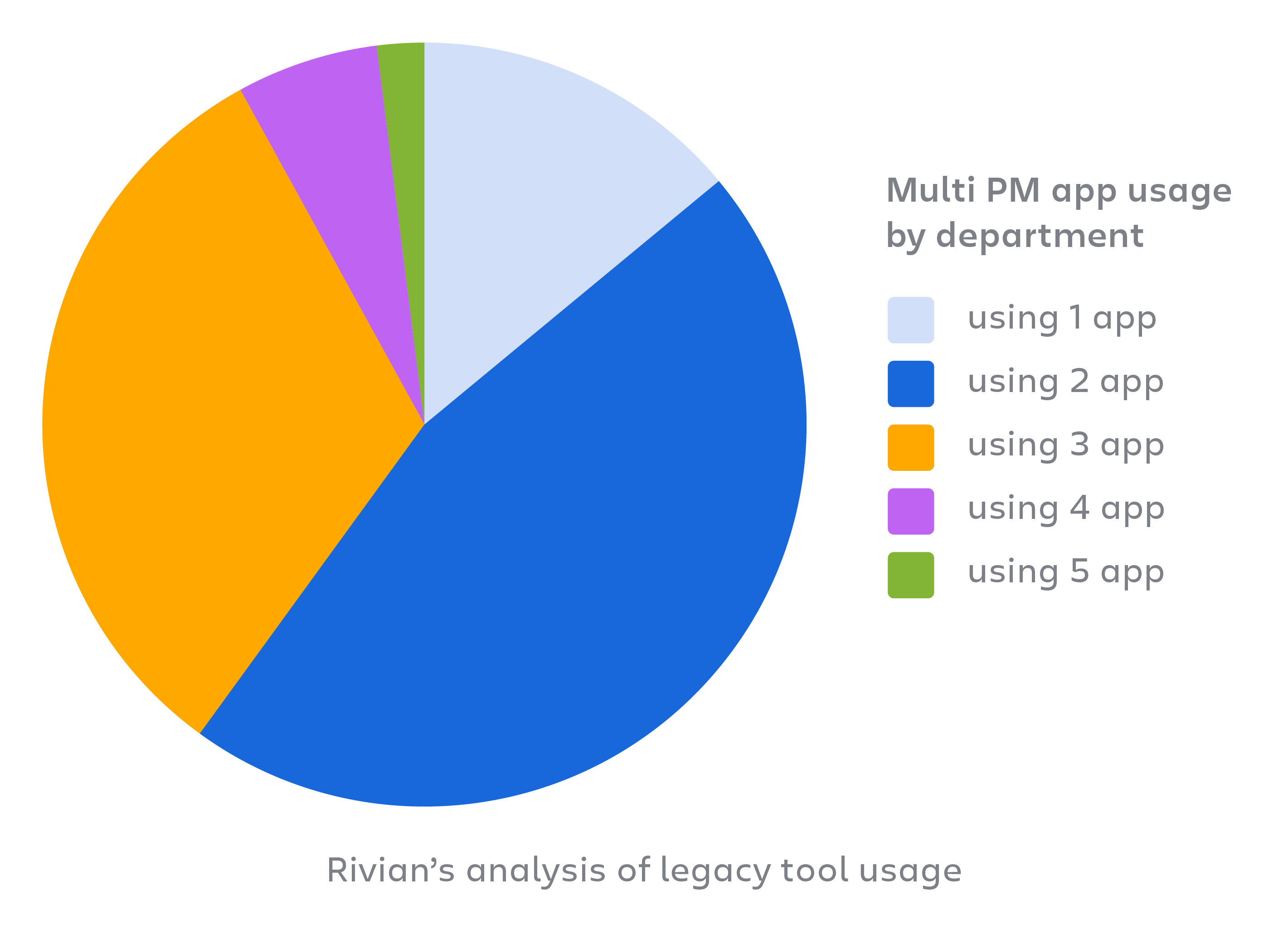
Through their analysis, the team saw that Jira not only had the highest usage, but also had overlapping features and functionality with the other tools. “It made the most sense to centralize on Atlassian,” Emily says. “The tools solved user needs, and a lot of people were using Jira already. We just needed to streamline miscellaneous project management needs onto that platform.”
A solution to save millions and satisfy users
With this data in mind, the Digital Workplace & Solutions Team built a business case to show how Rivian could consolidate tooling and help employees better connect, communicate, and collaborate. They partnered with Atlassian’s Business Value Advisory Team Lead Ben Center to complete a series of cost savings projections.
“We found we could save $2.5M annually by centralizing on Atlassian Cloud and adding governance. That’s an annual cost savings of 36%,” Emily says. “The process would involve reducing duplicate seats across tools, putting more governance in place, and limiting add-ons to other apps that were redundant with Atlassian Marketplace apps.”
Although the potential savings convinced Rivian’s Finance Team that Atlassian was the best solution, some users who were comfortable with other tools were understandably hesitant. To help overcome their concerns and gain buy-in, the Digital Workplace & Solutions Team took a “show, don’t tell” approach, showing stakeholders how they could use Jira and Jira Service Management to collaborate with each other and external vendors without relying on email. “Once we showed people how Jira worked, everyone said they wanted it,” says Senior Architect Mike Hayes.
Emily adds, “We also reassured people that we wouldn’t take away their current way of working until they were comfortable with Atlassian. We showed them how we were planning to improve and modernize processes along the way.” Rivian hoped that allowing teams to keep their legacy tools while they got familiar with Atlassian would ease the transition.
With full approval and buy-in from most users, Digital Workplace & Solutions started developing an agile migration and communication plan. Using Atlassian’s migration support tools, Rivian spent the next eight months helping around 10,000 users shift the majority of their work to Atlassian Cloud Enterprise.
Solution Engineering Manager Gustavo Moura says Rivian’s collaboration with Atlassian was crucial to the success of this initiative. “Our partnership with Atlassian was one of the reasons why this migration was possible,” he explains. “During the discovery phase, Atlassian provided recommendations. During the migrations, we found tools that Atlassian built to make the transition smoother. And since those migrations, they have always been open and willing to improve their work management products.”
A surprising change management strategy builds trust and long-term adoption
Throughout the migration and centralization process, Rivian managed change by communicating clearly and often; holding office hours for people who had questions or needed training; opening Slack channels for fast support; and accepting what Mike calls “intentional, short-term inefficiencies.”
For example, in some workflows, Rivian temporarily kept two duplicate fields in the same workflow. “They're the same field with the same data, but we kept the two so it would show what people were used to at first,” Mike explains. “We used Atlassian Automation behind the scenes to keep the fields the same, then reduced duplication over time. We didn’t just force them into it and meet resistance.”
These short-term inefficiencies paid off by building trust with users and laying the foundation for long-term adoption.
Transforming the purchase request process to save time and money
Using Atlassian cloud, Rivian has transformed several processes and built new teamwork solutions to improve efficiency, effectiveness, and the user experience. One such solution is their Internal Purchasing Review (IPR) system for reviewing purchases of all types and sizes.
Before, 300+ stakeholders used a variety of tools to submit, review, and approve about 2,200 purchases every month – and growing. The process worked, but the siloed departments, repetitive workflows, and assortment of tools with no source of truth hindered efficiency and scalability.
“Coupa cuts the checks, but you need context. It’s hard to be disciplined with spending if you don’t have context,” Mike says. “Now, we use Coupa to make payments, but there’s context and accountability in Atlassian.”
Increasing speed and standardization with a new solution
To solve these challenges, Digital Workspace & Solutions used Jira Service Management, Assets, Jira, and other integrated tools to build a new IPR solution that balances freedom and efficiency for users, with standardization and controls for the business.
Emily says, “Integrating Coupa with Jira Service Management allows us to pull Coupa data into JSM for historical reference and more context on each part. Stakeholders didn’t know what they were missing until we pulled them into Jira, connected them with other stakeholders, and showed them ways to optimize their review processes.”
Now, users can submit purchase requests via Coupa (although Jira Service Management could also handle intake).
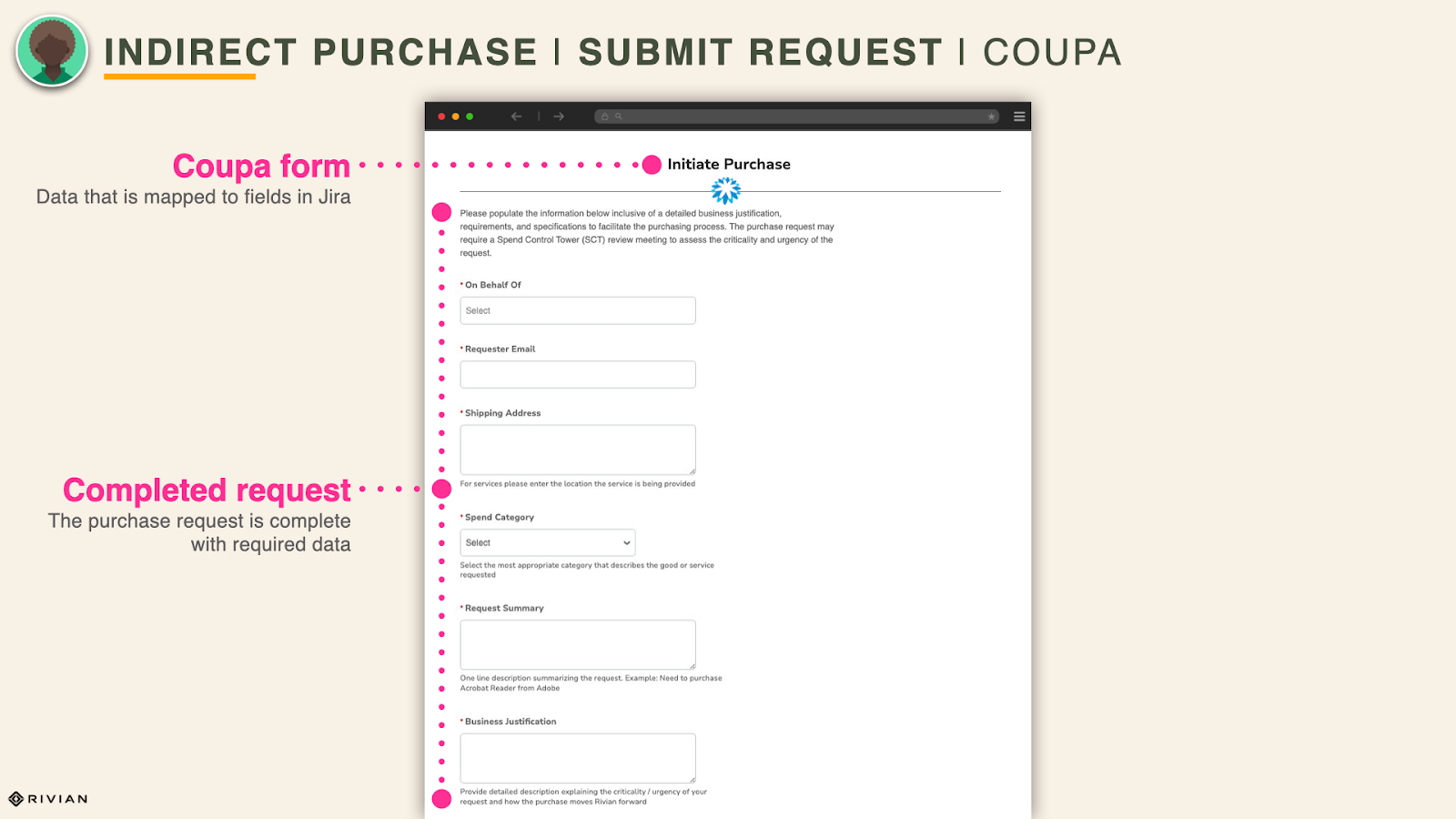
Then, submitted data is automatically pulled into a Jira Service Management ticket.
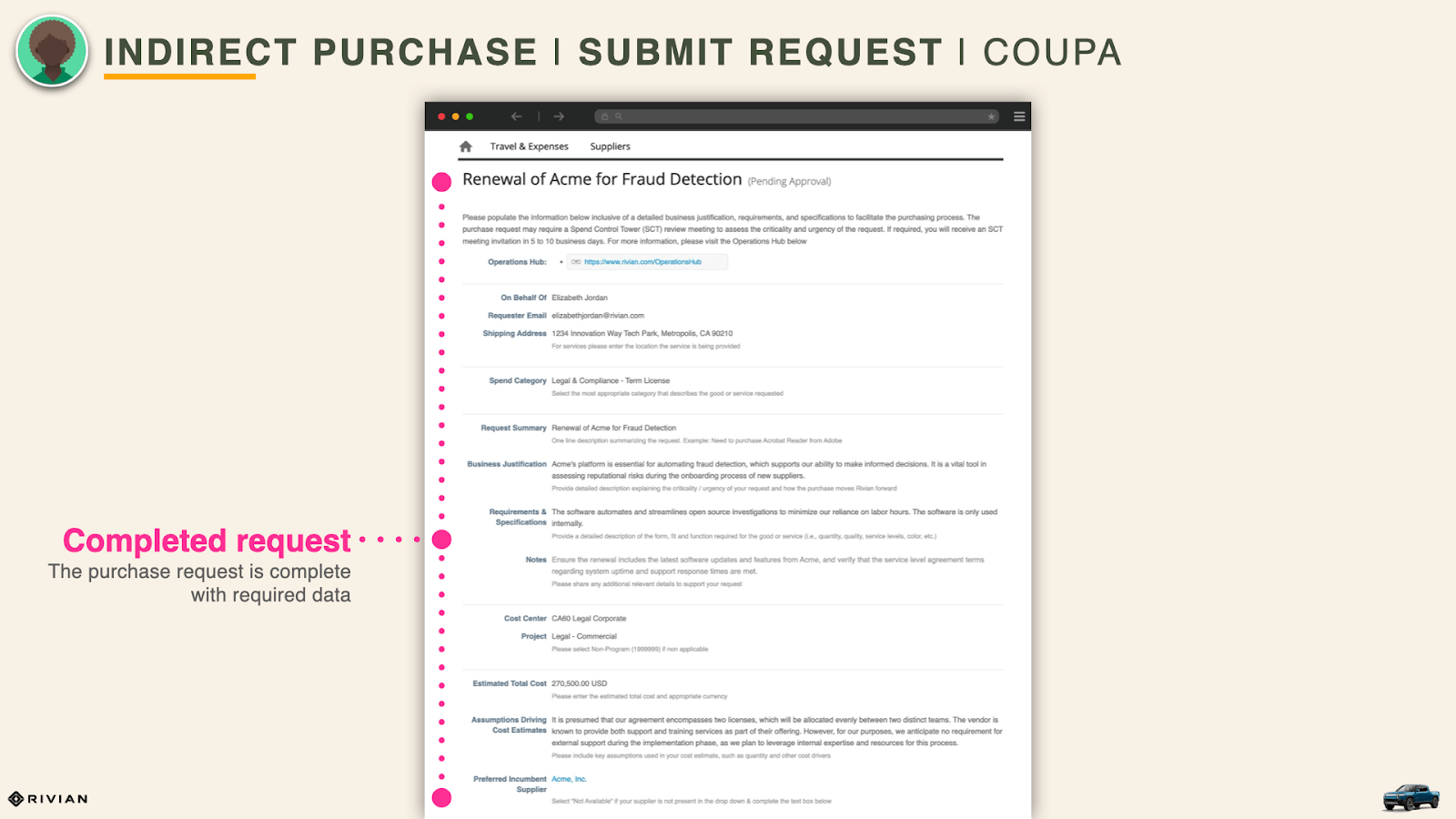
The ticket is assigned to the Finance Team to begin the four stages of review:
First, Finance determines if budget is available.
Once Finance approves, the request is sent to the Spend Control Tower, a subgroup of the Finance Team that determines if the purchase aligns with company priorities and rules.
For technology purchases, the request is automatically passed to the Tech Council (part of the IT organization) to evaluate the proposed solution from a technology perspective.
Finally, if the purchase is over $200,000, the Sourcing Council (part of the Procurement Team) determines whether the purchase should be made now or later.

Rivian’s Indirect Purchasing Workflow
Within each of these stages or “gates” of review, there are several tasks that stakeholders complete within Jira.
For example, the Spend Control Tower hosts five meetings every week to review requests. Atlassian Automation rules trigger a series of detailed emails to the council and stakeholders containing information about the meeting schedule and agenda, reminders about upcoming meetings, and an end-of-week summary of all meeting activity.

List of emails used to communicate with purchase request meeting attendees and stakeholders
“With Atlassian Automation, each stakeholder in the purchasing process is saving up to 60 hours every month on administrative work,” Mike says. “Using Automation isn’t just about time savings – it’s about freedom. We can spend our time more wisely.”
Creating a solution that manages these “gates” of review would have been impactful by itself. But Emily and Mike’s team had even more in mind.
Automation meets customization for a better user experience
In addition to streamlining the process for purchase reviews, Digital Workspace & Solutions gave thoughtful consideration to every field and email to create the best experience for all stakeholders. For example, cost estimates are displayed with dollar signs and commas so they are easy to read for approvers, while Atlassian Automation rules strip all formatting behind the scenes for calculations and reporting.
Each email was also crafted with users in mind. Before, creating and sending these emails was a manual process that took hours and resulted in frequent errors. Now users have thoughtful templates they can either quickly approve and queue up for automatic sending, or make changes and preview first before manually sending.
No detail was overlooked, including formatting meeting attendee names in such a way that they will populate properly in Outlook and Slack. For example, stakeholders receive automatic Slack notifications when there is an error that’s stalling the IPR process. The message not only notifies the right people about the error, but also provides clear instructions on how to resolve it and who to contact with questions.
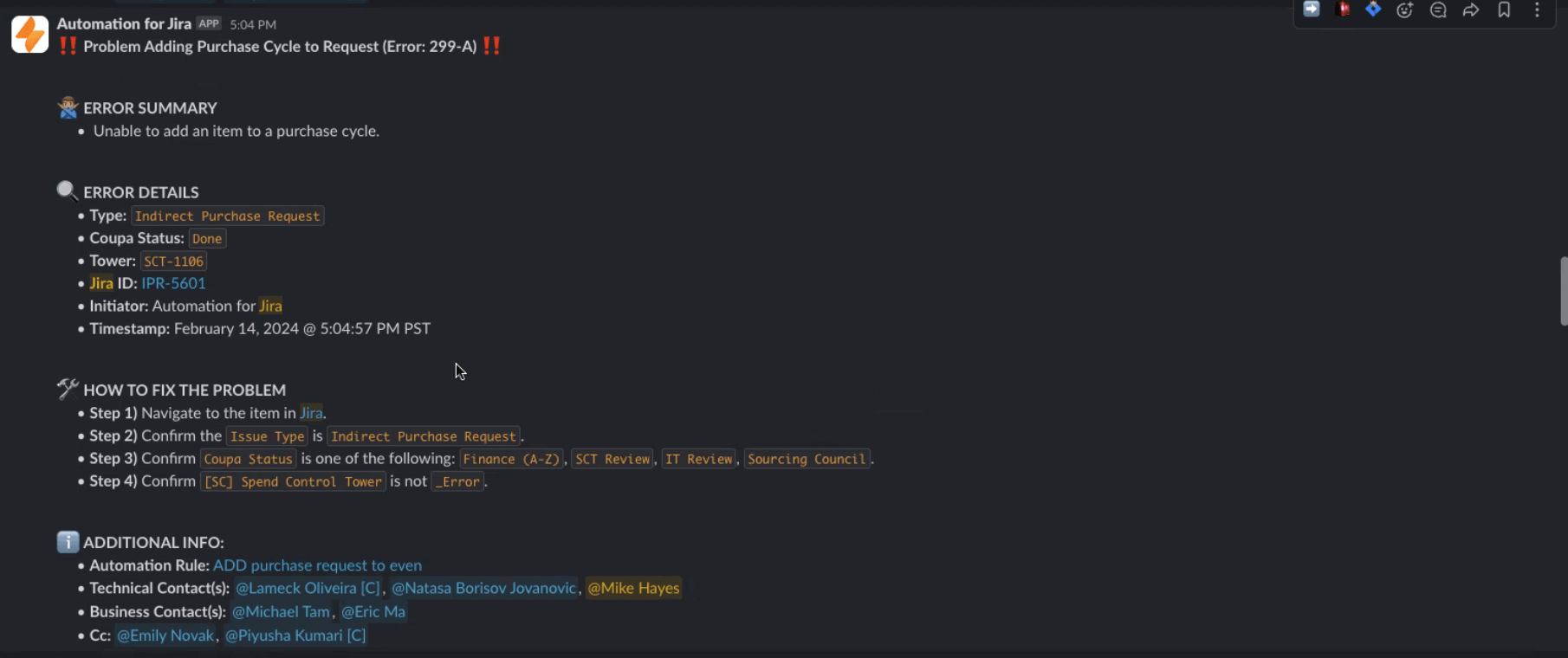
Automated Slack error notifications provide context and instructions for resolution
Plus, when reviewers want to adjust or add fields to the IPR workflow, they can self-serve instead of requiring developer assistance. While this empowers users with autonomy, Rivian has also added a layer of standardization by requiring users to select from a number of fields that have been pre-defined using Assets as a configuration management database.
Once requests are ready for review, stakeholders then run IPR meetings directly in Jira Service Management, using the solution to quickly view, approve, defer, or decline each purchase request.
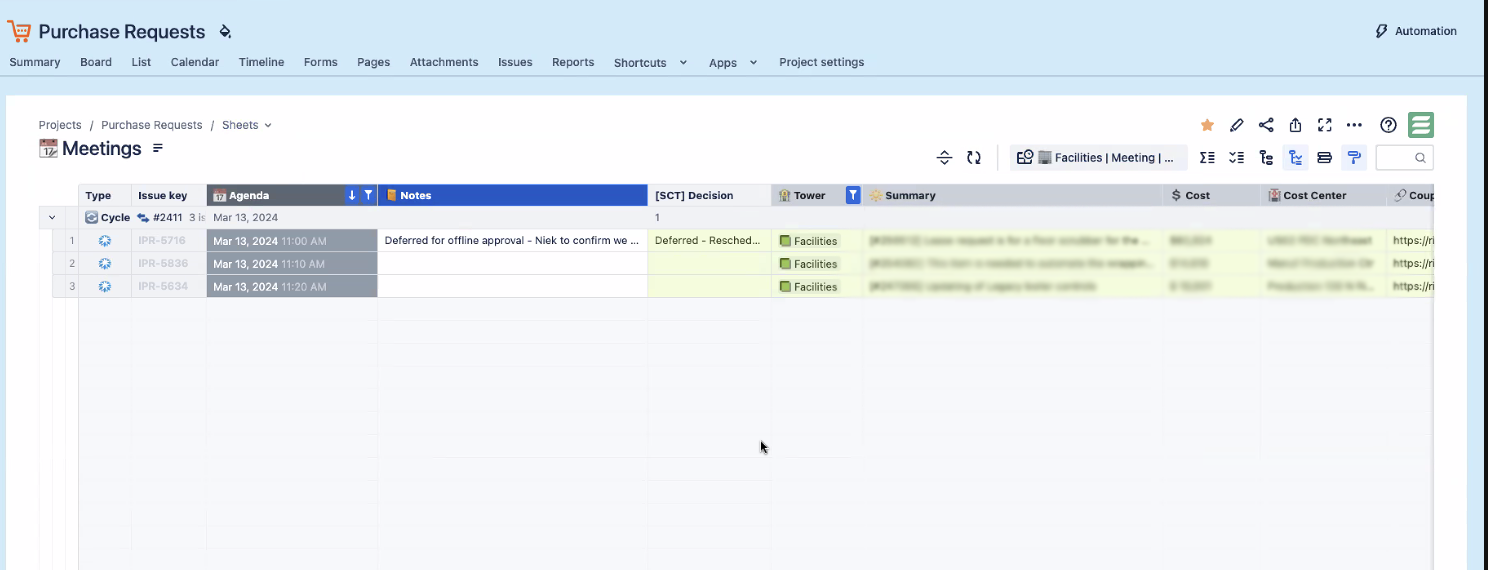
Agenda used to run IPR meetings and act on each request
As stakeholders are reviewing and managing requests, the JXL for Jira Marketplace app enables them to edit and organize each item like they would in Excel – a key feature users love for IPR and other workflows. “Without exaggeration, JXL sheets are life changing,” Mike says. “We have a diverse set of users with an equally diverse set of projects, and they all find JXL to be incredibly useful.”
Tight integrations between all of Rivian’s Atlassian and non-Atlassian tools involved in the IPR process ensure the most recent data is always reflected in each tool, no matter where it was entered. For example, when a stakeholder changes the status or description of a request in Coupa, that information is automatically changed in Jira Service Management too. Automation rules also map each ticket to the right group or individual, so if questions arise, stakeholders know who to contact.
One new solution sparks company-wide transformation
Much like their journey to reduce carbonization, Rivian is already seeing how small process and technology improvements can make a big impact. Centralizing on Atlassian Cloud Enterprise and creating new solutions like the Internal Purchase Review flow have already saved millions, improved the user experience, and laid the foundation for scaling without losing the freedom required for innovation. Plus, with Atlassian Analytics, Rivian can leverage all of the data in their Atlassian apps to create reports and dashboards, empowering them to make more informed decisions while saving money on third-party apps.
Today, employees are spending more of their valuable time collaborating on work that requires problem solving and discussion (such as meeting to debate whether a purchase should be approved), instead of basic tasks like switching apps, updating tickets, compiling agendas, and emailing meeting summaries. Plus, users have more context and historical reference to make better decisions.
Digital Workplace & Solutions is looking ahead to new use cases and ideas for improvements, including centralizing Rivian’s Service Organization, Facilities, and vendor management processes. “The IPR solution can be applied to other processes because now there’s a relationship between all of our data and tools,” Mike says.
From tools for employees to cars for customers, Rivian is approaching each challenge with a collaborative mindset to achieve goals together that would be impossible alone. Rivian says, “Our story is about people coming together with one mission in mind: To protect our planet and the cultures that inhabit it for generations to come.”
About Rivian
Rivian (NASDAQ: RIVN) is an American automotive manufacturer that develops and builds category-defining electric vehicles and accessories. The company creates innovative and technologically advanced products that are designed to excel at work and play with the goal of accelerating the global transition to zero-emission transportation and energy.
Industry
Automotive
Number of users
10,000
Location
Americas
Atlassian Marketplace Apps
Check these out

